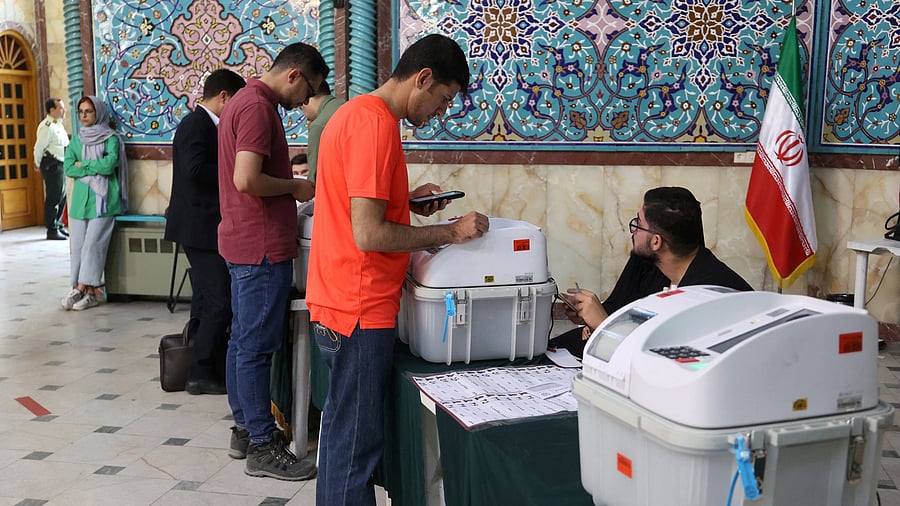
Once the list of candidates is finalised, a free and fair election campaign ensues on a level playing field.
Credit: Reuters Photo
It is a fascinating time to be in Iran through the penultimate week of the animated campaign by six candidates running for the presidency in the snap elections on June 28 following the sudden death of President Ibrahim Raisi in a helicopter crash.
The Guardian Council ultimately decided on six candidates being allowed on the ballot and the litmus test (aided by the interior ministry) is about a presidential aspirant’s commitment to the ideals and principles of the 1979 Islamic Revolution and the system of governance based on the doctrine of Velayat-e faqih or ‘Guardianship of the jurist’ — the crux of Shia Islamism.
Once the list of candidates is finalised, a free and fair election campaign ensues on a level playing field, characterised by animated public discussions and debates.
In the folklore of Western media, Iran’s political personalities are branded as either ‘conservatives’ or ‘reformists’. The three candidates who have surged lately include two ‘conservatives’ — Saeed Jalili, and Mohammad Baqer Qalibaf — and a third, Masoud Pezeshkian with ‘reformist’ leaning. All three are non-clerics.
However, the two ‘conservatives’ are anything but birds of the same feather. Both Jalili and Qalibaf fought in the ranks of the Islamic Revolutionary Guards (IRGC) during the Iran-Iraq War, but Jalili chose a diplomatic career and rose to become Deputy Foreign Minister, Secretary of the Supreme National Security Council, and aide to the Supreme Leader. He was Iran’s nuclear negotiator too. His forte is national security.
Qalibaf built his career as a commander of the IRGC’s Air Force and Iran’s Chief of Police before entering active politics, and getting elected to the coveted position of Mayor of Tehran where he performed brilliantly. From that staging post, he moved on to become Speaker of Iran’s parliament in 2020.
Their political bases differ. Jalili is a hardcore progeny of the Islamic Revolution, while Qalibaf is a pragmatist who made his mark as an administrator, and whose name has been linked to business interests reminding one of former President Hashemi Rafsanjani. Jalili espouses a caring State while Qalibaf doesn’t share his leftist credentials and is a politician ‘who gets things done’.
Both Jalili and Qalibaf are politicians with a habitation and name and branding them as ‘conservatives’ in the same breath is a travesty. They have a record of clashing with each other in the 2013 presidential election, which resulted in the runaway victory of Hassan Rouhani, a Sharia lawyer and Islamic cleric who as president negotiated the Iran nuclear deal (JCPOA) with the United States.
When it comes to ‘reformist’ Pezeshkian, things get more curious, as his political base comprises a coalition of strange bedfellows. He draws support from former President Rouhani’s camp as well as the well-known reformist President Mohammad Khatami (son of an Ayatollah
and a cleric himself, who advocated freedom of expression, tolerance and civil society, press freedom, and an economic policy that supported free market and foreign investment.)
Pezeshkian is a medical doctor, former minister of health and a sitting MP with a reputation for being a man of impeccable integrity and genuinely capable of compassion for the poor. Being the son of an Azeri father and a Kurdish mother, he may also draw support from ethnic minority groups.
Traditionally, the outcome of Iranian elections is hard to predict. It’s a toss-up between Pezeshkian and Qalibaf. Much will depend on whether a runoff becomes necessary if neither marshals 50 per cent of votes in the first round on June 28, which, most people visualise as unlikely, or, one of the three candidates withdraws at the last minute. The point is that the three candidates represent three distinct groups of followers.
The priority for the next president is going to be the economic and social issues which have reached a level of criticality. A common refrain is that an average Iranian needs to have two jobs to support his family.
A commonality with India is that Iran too has an impressive growth rate but that has not led to job creation. The rate of inflation is about 50 per cent.
An interesting twist to the tale is that while no candidate demands the removal of hijab laws, they agreed during TV debates that the government should not use coercion to enforce the controversial laws, either. This is emblematic of the national mood. Iran faces no threat of external aggression. Its rise as a regional power is unstoppable. And when it comes to the election this Friday, it’s the economy, stupid!
(The writer is a former diplomat)